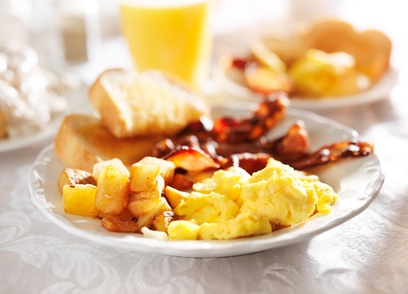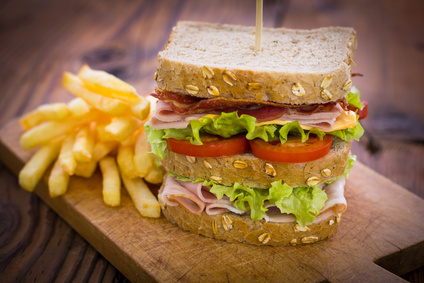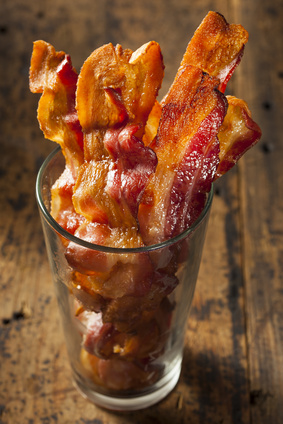Let Us Count the Ways WE LOVE to LOVE BACON…
Breakfast
Lunch
Dinner
Bacon is a meat product prepared from a pig and usually cured. It is first cured using large quantities of salt, either in a brine or in a dry packing; the result is fresh bacon(also known as green bacon). Fresh bacon may then be further dried for weeks or months in cold air, or it may be boiled or smoked. Fresh and dried bacon is typically cooked before eating. Boiled bacon is ready to eat, as is some smoked bacon, but may be cooked further before eating.
Bacon is prepared from several different cuts of meat. It is usually made from side and back cuts of pork, except in the United States, where it is almost always prepared from pork belly (typically referred to as “streaky”, “fatty”, or “American style” outside of the US and Canada). The side cut has more meat and less fat than the belly. Bacon may be prepared from either of two distinct back cuts: fatback, which is almost pure fat, and pork loin, which is very lean. Bacon-cured pork loin is known as back bacon.
Bacon may be eaten smoked, boiled, fried, baked, or grilled, or used as a minor ingredient to flavour dishes. Bacon is also used for barding and larding roasts, especially game, including venison and pheasant. Bacon has even been bottled as a jam!
The word is derived from the Old High German bacho, meaning “buttock”, “ham” or “side of bacon”, and cognate with the Old French bacon.
In continental Europe, part of the pig is not usually smoked like bacon is in the United States; it is used primarily in cubes (lardons) as a cooking ingredient, valued both as a source of fat and for its flavour. In Italy, this is called pancetta and is usually cooked in small cubes or served uncooked and thinly sliced as part of an antipasto.
Meat from other animals, such as beef, lamb, chicken, goat, or turkey, may also be cut, cured, or otherwise prepared to resemble bacon, and may even be referred to as “bacon.” Such use is common in areas with significant Jewish and Muslim populations, both of which prohibit the consumption of pigs. The USDA defines bacon as “the cured belly of a swine carcass”; other cuts and characteristics must be separately qualified (e.g., “smoked pork loin bacon”). > Source: http://en.wikipedia.org/wiki/Bacon
What’s Next for the Bacon?
In the future, we see the glass as MORE than half-full for Bacon 🙂





Leave a Reply